The Impact of Secondary Phyllosilicate Minerals on the Engineering Properties of Various Igneous Aggregates from Greece
Abstract
1. Introduction
2. Geological Setting
3. Materials and Methods
4. Results
4.1. Petrographic Features
4.2. X-ray Diffraction and Quantitative Analysis of Aggregates
4.3. Scanning Electron Microscopy
4.3.1. Surface Texture of the Studied Aggregates
4.3.2. SEM Study of Clay Minerals
4.4. Physicomechanical Properties of Aggregates
5. Discussion
5.1. The Impact of Secondary Phyllosilicate Minerals on Engineering Properties of Ultramafic Rocks
5.2. The Impact of Secondary Phyllosilicate Minerals on Engineering Properties of Mafic Rocks
5.3. The Impact of Secondary Phyllosilicate Minerals on Engineering Properties of Volcanic Rocks
6. Conclusions
Author Contributions
Funding
Acknowledgments
Conflicts of Interest
References
- Langer, W.H. The Geologic Occurrence of Potential Sources of Crushed Stone and Sand and Gravel for Use as Natural Aggregate and a Summary of the Natural Aggregate Industry; U.S Geological Survey Bulletin 1594; Department of the Interior Donald Paul Hodel Washington: Washington, DC, USA, 1988. [Google Scholar]
- Shakoor, A.; Bonelli, R.E. Relationship between petrographic characteristics, engineering index properties and mechanical properties of selected sandstones. Bull. Assoc. Eng. Geol. 1991, XXVII, 55–71. [Google Scholar] [CrossRef]
- Haney, M.G.; Dhakoor, A. The relationship between tensile and compressive strengths for selected sandstones as influenced by index properties and petrographic characteristics. In Proceedings of the 7th International. IAEG Congress, Lisbon, Portugal, 5–9 September 1994; Volume IV, pp. 3013–3021. [Google Scholar]
- Turgul, A.; Zarif, I.H. Correlation of mineralogical and textural characteristics with engineering properties of selected granitic rocks from Turkey. Eng. Geol. 1999, 51, 303–317. [Google Scholar]
- Smith, M.R.; Collis, L. Aggregates: Sand, Gravel and Crushed Rock Aggregates for Construction Purposes; Spec. Publ. 17; The Geological Society: London, UK, 2001. [Google Scholar]
- Miskovsky, K.; Tabora, D.M.; Kou, S.Q.; Lindqvist, P.A. Influence of the mineralogical composition and textural properties on the quality of coarse aggregates. J. Mater. Eng. Perform. 2004, 13, 144–150. [Google Scholar] [CrossRef]
- Al-Oraimi, S.K.; Taha, R.; Hassan, H.F. The effect of the mineralogy of coarse aggregate on the mechanical properties of high-strength concrete. Constr. Build. Mater. 2006, 20, 499–503. [Google Scholar] [CrossRef]
- Petrounias, P.; Rogkala, A.; Kalpogiannaki, M.; Tsikouras, B.; Hatzipanagiotou, K. Comparative study of physico-mechanical properties of ultrabasic rocks (Veria-Naousa ophiolite) and andesites from central Macedonia (Greece). Bull. Geol. Soc. Greece 2016, 50, 1989–1998. [Google Scholar] [CrossRef]
- Giannakopoulou, P.P.; Tsikouras, B.; Hatzipanagiotou, K. The interdependence of mechanical properties of ultramafic rocks from Gerania ophiolitic complex. Bull. Geol. Soc. Greece 2016, 50, 1829–1837. [Google Scholar] [CrossRef]
- Rigopoulos, I.; Tsikouras, B.; Pomonis, P.; Hatzipanagiotou, K. The impact of petrographic characteristics on the engineering properties of ultrabasic rocks from northern and central Greece. Q. J. Eng. Geol. Hydrogeol. 2012, 45, 423–433. [Google Scholar] [CrossRef]
- Petrounias, P.; Giannakopoulou, P.P.; Rogkala, A.; Stamatis, P.M.; Tsikouras, B.; Papoulis, D.; Lampropoulou, P.; Hatzipanagiotou, K. The Influence of Alteration of Aggregates on the Quality of the Concrete: A Case Study from Serpentinites and Andesites from Central Macedonia (North Greece). Geosciences 2018, 8, 115. [Google Scholar] [CrossRef]
- Yilmaz, N.G.; Goktan, R.M.; Kibici, Y. Relations between some quantitative petrographic characteristics and mechanical strength properties of granitic building stones. Int. J. Rock Mech. Min. Sci. 2011, 48, 506–513. [Google Scholar] [CrossRef]
- Rigopoulos, I.; Tsikouras, B.; Pomonis, P.; Hatzipanagiotou, K. The influence of alteration on the engineering properties of dolerites: The example from the Pindos and Vourinos ophiolites (northern Greece). Int. J. Rock Mech. Min. Sci. 2010, 47, 69–80. [Google Scholar] [CrossRef]
- Diamantis, K.; Gartzos, E.; Migiros, G. Study on uniaxial compressive strength, point load strength index, dynamic and physical properties of serpentinites from Central Greece: Test results and empirical relations. Eng. Geol. 2009, 108, 199–207. [Google Scholar] [CrossRef]
- Pola, A.; Crosta, G.; Fusi, N.; Barberini, V.; Norini, G. Influence of alteration on physical properties of volcanic rocks. Tectonophysics 2012, 566–567, 67–86. [Google Scholar] [CrossRef]
- Ündül, Ö. Assessment of mineralogical and petrographic factors affecting petro-physical properties, strength and cracking processes of volcanic rocks. Eng. Geol. 2016, 210, 10–22. [Google Scholar] [CrossRef]
- Gresens, R.L. Composition-volume relationships of metasomatism. Chem. Geol. 1967, 2, 47–65. [Google Scholar] [CrossRef]
- Veniale, F.; van der Marel, H.D. An interstratified saponite-swelling chlorite mineral as a weathering product of lizardite rock from St. Margherita Staffora (Pavia Province), Italy. Beitr. Miner. Petrogr. 1963, 9, 198–245. [Google Scholar]
- Wildman, W.E.; Jackson, M.L.; Whittig, L.D. Iron-rich montmorillonite formation in soils derived from serpentinites. Soil Sci. Soc. Am. Proc. 1968, 32, 787–794. [Google Scholar] [CrossRef]
- Ducloux, J.; Mennier, A.; Velde, B. Smectite, chlorite and a regular interstratified chlorite-vermiculite in soils developed on a small serpentinite body Massif Central, France. Clay Miner. 1976, 11, 121–135. [Google Scholar] [CrossRef]
- Garcia, A.; Delgado, M. Mineralogia de las fracciones arenosas de suelos desarrollados sobre serpentinas en la Sierra de Carratraca (Malaga). Anal. Edafol. Agrobiol. 1978, 37, 599–620. [Google Scholar]
- Istok, J.D.; Harward, M.E. Influence of soil moisture on smectite formation in soils derived from serpentite. Soil. Sci. Soc. Am. J. 1982, 46, 1106–1108. [Google Scholar] [CrossRef]
- Hurlbut, C.S.; Sharp, W.E. Dana’s Minerals and How to Study Them (After Edward Salisbury Dana), 4th ed.; John Wiley & Sons, Inc.: New York, NY, USA, 1998; pp. 248–257. [Google Scholar]
- Escartin, J.; Hirth, G.; Evans, B. Strength of slightly serpentinized peridotites: Implications for the tectonics of oceanic lithosphere. Geology 2001, 29, 1023–1026. [Google Scholar] [CrossRef]
- Frost, B.R.; Beard, J.S. On silica activity and serpentinization. J. Petrol. 2007, 48, 1351–1368. [Google Scholar] [CrossRef]
- Shervais, J.W.; Kolesar, P.; Andreasen, K. A field and chemical study of serpentinization—Stonyford, California: Chemical flux and mass balance. Int. Geol. Rev. 2005, 47, 1–23. [Google Scholar] [CrossRef]
- Deschamps, F.; Godard, M.; Guillot, S.; Hattori, K. Geochemistry of subduction zone serpentinites: A review. Lithos 2013, 178, 96–127. [Google Scholar] [CrossRef]
- Malvoisin, B. Mass transfer in the oceanic lithosphere: Serpentinization is not isochemical. Earth Planet. Sci. Lett. 2015, 430, 75–85. [Google Scholar] [CrossRef]
- Chidester, A.H.; Albee, A.L.; Cady, W.M. Petrology, Structure and Genesis of the Asbestos-Bearing Ultramafic Rocks of the Belvidere Mountain Area in Vermost; U.S. Geological Survey Professional Paper No 1016; U.S. Government Print Office: Washington, DC, USA, 1978. [Google Scholar]
- Pohl, W. Large scale metallogenic features of Pan African in east Africa, Nubia and Arabia. Bull. Fac. Earth Sci. King Abdulaziz Univ. Jeddah 1984, 6, 592–601. [Google Scholar]
- El-Gaby, S.; List, F.K.; Tehrani, R. Geology, evolution and metallogenesis of the Pan African belt in Egypt. In The Pan African Belt of Northeast Africa and Adjacent Areas; El-Gaby, S., Greling, R.O., Eds.; Vieweg: Braunschweig, Germany, 1988; pp. 17–68. [Google Scholar]
- Hussein, A.A. Mineral deposits of Egypt. In The Geology of Egypt; Said, R., Ed.; Elsevier: Amsterdam, The Netherlands, 1990; pp. 511–566. [Google Scholar]
- Salem, I.A. Talc deposits at Rod El-Tom and Umm El-Dalalil areas, Eastern Desert. Egypt J. Geol. 1992, 36, 175–189. [Google Scholar]
- Morad, S. Mica Alteration Reactions in Jurassic Reservoir sandstones from the Haltenbanken Area, offshore Norway. Clays Clay Miner. 1990, 38, 584–590. [Google Scholar] [CrossRef]
- Bettison, L.A.; Schiffman, P. Compositional and Structural variations of phyllosillicates from the Point Soil ophiolite, California. Am. Mineral. 1988, 79, 671–695. [Google Scholar]
- Stoch, I.; Sikora, W. Transformation of micas in the process of kaolinitization of granites and gneisses. Clays Clay Miner. 1976, 24, 156–162. [Google Scholar] [CrossRef]
- Srodon, J.; Ebert, D.D. Illite. Rev. Mineral. 1984, 13, 495–544. [Google Scholar]
- Innoue, A.; Utada, M. Further investigations of a conversion series of dioctahedral mica/smectite in the Shinzan hydrothermal alteration area, north- east Japan. Clays Clay Miner. 1983, 31, 401–412. [Google Scholar] [CrossRef]
- Kranidiotis, P.; MacLean, W.H. Systematics of chlorite alteration at the Phelps Dodge massive sulfide deposit, Matagami. Quebec Econ. Geol. 1987, 82, 1898–1911. [Google Scholar]
- Shikazono, N.; Kawahata, H. Compositional differences in chlorite from hydrothermally altered rocks and hydrothermal ore deposits. Can. Mineral. 1987, 25, 465–474. [Google Scholar]
- Tiwari, B.; Ajmera, B. Consolidation and swelling behavior of major clay minerals and mixtures. Appl. Clay Sci. 2011, 54, 264–273. [Google Scholar] [CrossRef]
- Bish, D.L.; Howard, S.A. Quantitative phase analysis using the Rietveld Method. J. Appl. Cryst. 1988, 21, 86–91. [Google Scholar] [CrossRef]
- Bish, D.L.; Post, J.E. Quantitative mineralogical analysis using the Rietveld full pattern fitting method. Am. Mineral. 1993, 78, 932–940. [Google Scholar]
- Bish, D.L.; Plotze, M. X-ray powder diffraction with emphasis on qualitative and quantitative analysis in industrial mineralogy. In Advances in the Characterization of Industrial Minerals; EMU Notes in Mineralogy; Mineralogical Society: London, UK, 2011; Volume 9, pp. 35–76. [Google Scholar]
- McCusker, L.B.; Von Dreele, R.B.; Cox, D.E.; Louer, D.; Scardi, P. Rietveld refinement guidelines. J. Appl. Crystallogr. 1999, 32, 36–50. [Google Scholar] [CrossRef]
- Hillier, S. Accurate quantitative analysis of clay and other minerals in sandstones by XRD: Comparison of a Rietveld and a reference intensity ratio (RIR) method and the importance of sample preparation. Clay Miner. 2000, 35, 291–302. [Google Scholar] [CrossRef]
- Gualtieri, A.F. Accuracy of XRPD QPA using the combined Rietveld-RIR Method. J. Appl. Crystallogr. 2000, 33, 267–278. [Google Scholar] [CrossRef]
- Rogkala, A.; Petrounias, P.; Tsikouras, B.; Hatzipanagiotou, K. New occurrence of pyroxenites in the Veria-Naousa ophiolite (north Greece): Implications on their origin and petrogenetic evolution. Geosciences 2017, 7, 92. [Google Scholar] [CrossRef]
- Decourt, J.; Aubouin, J.; Savoyat, E. Le sillon mesohellenique et la zone pelagonienne. Bull. Soc. Geol. Fr. 1977, 1, 32–70. [Google Scholar]
- Michailidis, K.M. Zoned chromites with high Mn-contents in the Fe-Ni-Cr-laterite ore deposits from the Edessa area in Northern Greece. Miner. Depos. 1990, 25, 190–197. [Google Scholar] [CrossRef]
- Pe-Piper, G.; Piper, D.J.W. The Igneous Rocks of Greece. The Anatomy of an Orogen; Gebrder Borntaeger: Berlin, Germany, 2002. [Google Scholar]
- Saccani, E.; Photiades, A.; Santato, A.; Zeda, O. New evidence for supra-subduction zone ophiolites in the Vardar zone of northern Greece: Implications for the tectonomagmatic evolution of the Vardar oceanic basin. Ofioliti 2008, 33, 65–85. [Google Scholar]
- Boccaletti, M.; Manetti, P.; Peccerillo, A. The Balkanides as an Instance of Back-Arc Thrust Belt: Possible relation with the Hellinides. Geol. Soc. Am. Bull. 1974, 85, 1077–1084. [Google Scholar] [CrossRef]
- Eleftheriadis, G.; Castorina, F.; Soldatos, T.; Masi, U. Geochemical and Sr-Nd isotopic evidence for the genesis of the Late Cainozoic Almopia volcanic rocks (Central Macedonia, Greece). Mineral. Petrol. 2003, 78, 21–36. [Google Scholar] [CrossRef]
- Clément, B. Evolution Géodynamique d’un Secteur des Hellénides Internes: L’Attique-Béotie (Gréce Continentale). Ph.D. Thesis, University of Lille, Lille, France, 1983. [Google Scholar]
- Vacondios, I. Etude Metallogenique des Chromites Liees aux Ophiolites de Type Mediterranee Occdentale ou Orientale: Le Chromites de Tinos et des Gerannees. Ph.D. Thesis, University of Patras, Patras, Greece, 1997. [Google Scholar]
- Danelian, T.; Robertson, A.H.F. Palaeogeographic implications of the age of radiolarian-rich sediments in Beotia (Greece). Bull. Geol. Soc. Greece 1998, 32, 21–29. [Google Scholar]
- Zachariadis, P.; Kostopoulos, D.; Reischmann, T.; Himmerkus, F.; Matukov, D.; Sergeev, S. U-Pb ion-microprobe zircon dating of subduction-related magmatism from northern Greece: The ages of the Guevgueli, Thessaloniki and Chalkidiki igneous complexes. Geophys. Res. Abstr. 2006, 8, 055560. [Google Scholar]
- Saccani, E.; Bortolotti, V.; Marroni, M.; Pandolfi, L.; Photiades, A.; Principi, G. The Jurassic association of backarc basin ophiolites and calc-alkaline volcanics in the Guevgueli complex (Northern Greece): Implication for the evolution of the Vardar zone. Ofioliti 2008, 33, 209–227. [Google Scholar]
- Freyberg, B.V. Geologie des Isthmus von Korinth. Erlanger Geologische Abhandlungen, 95; Junge and Sohn, Universitats-Buchdruckerei: Enlangen, Germany, 1973. [Google Scholar]
- EN 932-1. Part 1: Composition, Specifications and Conformity Criteria for Common Cements; European Standard: Pilsen, Czech Republic, 2011.
- EN 932. Part 3: Procedure and Terminology for Simplified Petrographic Description; European Standard: Pilsen, Czech Republic, 1996.
- BSI (British Standards Institution). Part 1: Methods for Determination of Particle Size and Shape. In Methods for Sampling and Testing of Mineral Aggregates, Sands and Fillers; BSI: London, UK, 1975. [Google Scholar]
- AASHTO (American Association of State Highway and Transportation Officials). Standard Method of Test for Total Evaporable Moisture Content of Aggregate by Drying; T255; AASHTO: Washington, DC, USA, 2000. [Google Scholar]
- ISRM Suggested method for determining point load strength. Int. J. Rock Mech Min. Sci. Geomech. Abstr. 1985, 22, 51–62.
- ASTM C-131. In Resistance to Abrasion of Small-Size Coarse Aggregate by Use of the Los Angeles Machine; American Society for Testing and Materials: Philadelphia, PA, USA, 1989.
- ASTM D-2938. In Standard Test Method of Unconfined Compressive Strength of Intact Rock Core Specimens; Annual Book of Standards, 4.08; American Society for Testing and Materials: Philadelphia, PA, USA, 1986.
- Sabatakakis, N.; Koukis, G.; Tsiambaos, G.; Papanakli, S. Index properties and strength variation controlled by microstructure for sedimentary rocks. Eng. Geol. 2008, 97, 80–90. [Google Scholar] [CrossRef]
- Diamantis, K.; Gartzos, E.; Migiros, G. Influence of petrographic characteristics on physico-mechanical properties of ultrabasic rocks from central Greece. Bull. Eng. Geol. Environ. 2014, 73, 1273–1292. [Google Scholar] [CrossRef]
- Undul, O.; Turgul, A. On the variations of geo-engineering properties of dunites and diorites related to weathering. Environ. Earth Sci. 2016, 75, 1326. [Google Scholar] [CrossRef]
- Weinert, H.H. Basic Igneous Rocks in Road Foundations; CSIR Research Report No. 218; Soil Mechanics Division, National Institute for Roads Research: Pretoria, South Africa, 1964; p. 47. [Google Scholar]
- Weidler, P.G.; Luster, J.; Schneider, J.; Sticher, C.H.; Gehring, A.U. The Rietveld method applied to the quantitative mineralogical and chemical analysis of a ferralitic soil. Eur. J. Soil Sci. 2008, 49, 95–105. [Google Scholar] [CrossRef]
- Taylor, R.K.; Smith, T.J. The engineering geology of clay minerals; swelling, shrinking and mudrock breakdown. Clay Miner. 1986, 21, 235–260. [Google Scholar] [CrossRef]
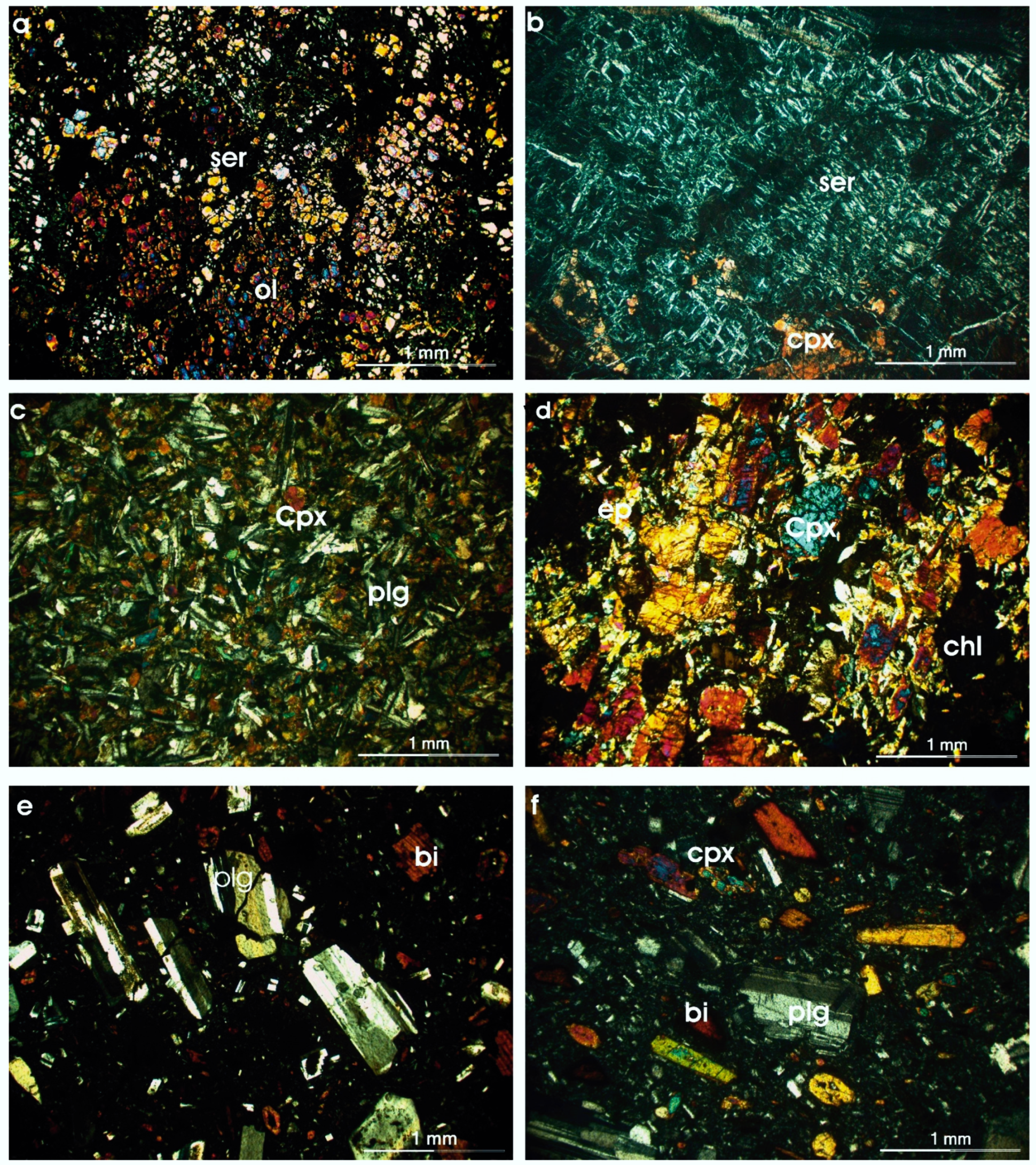
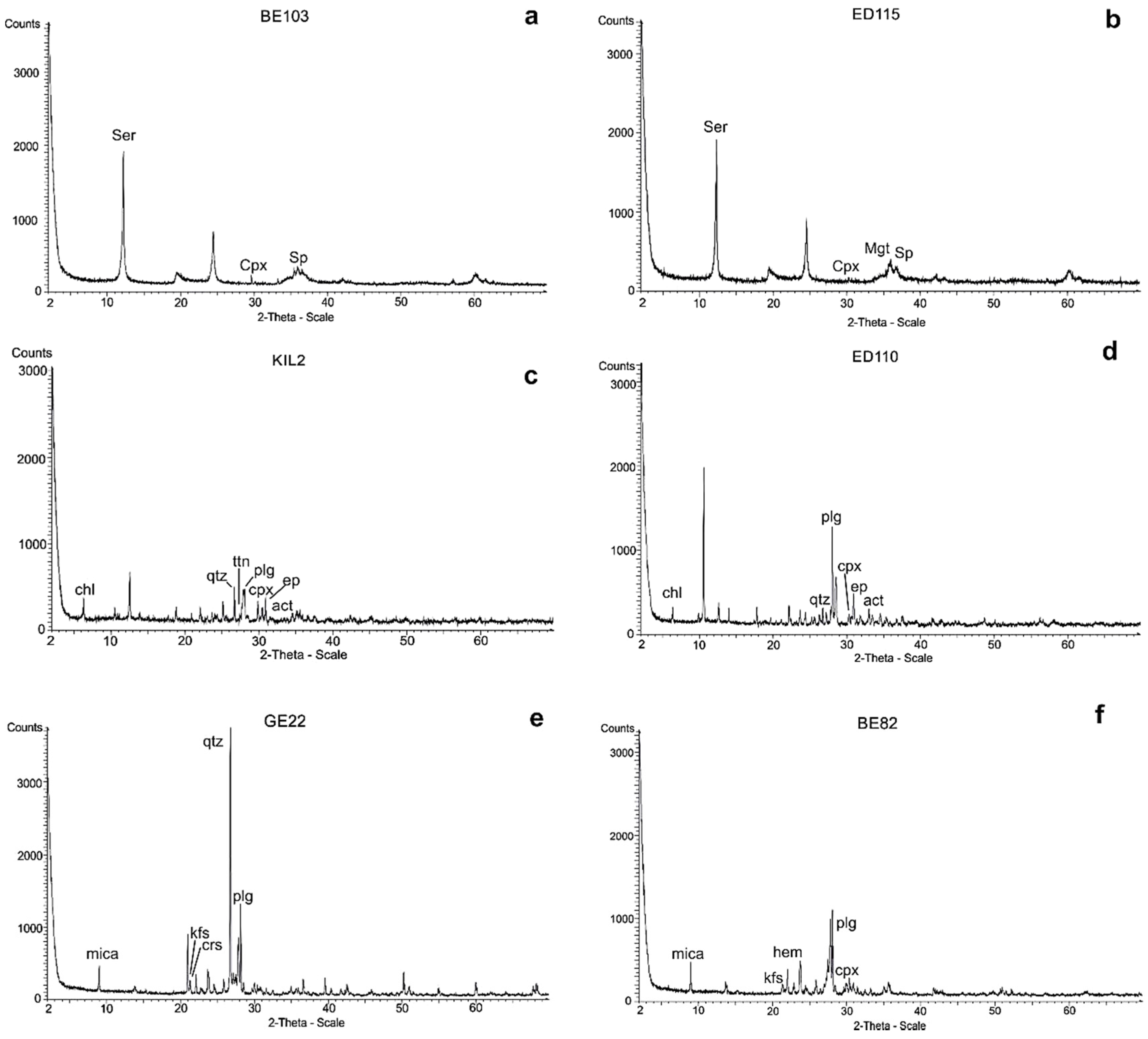
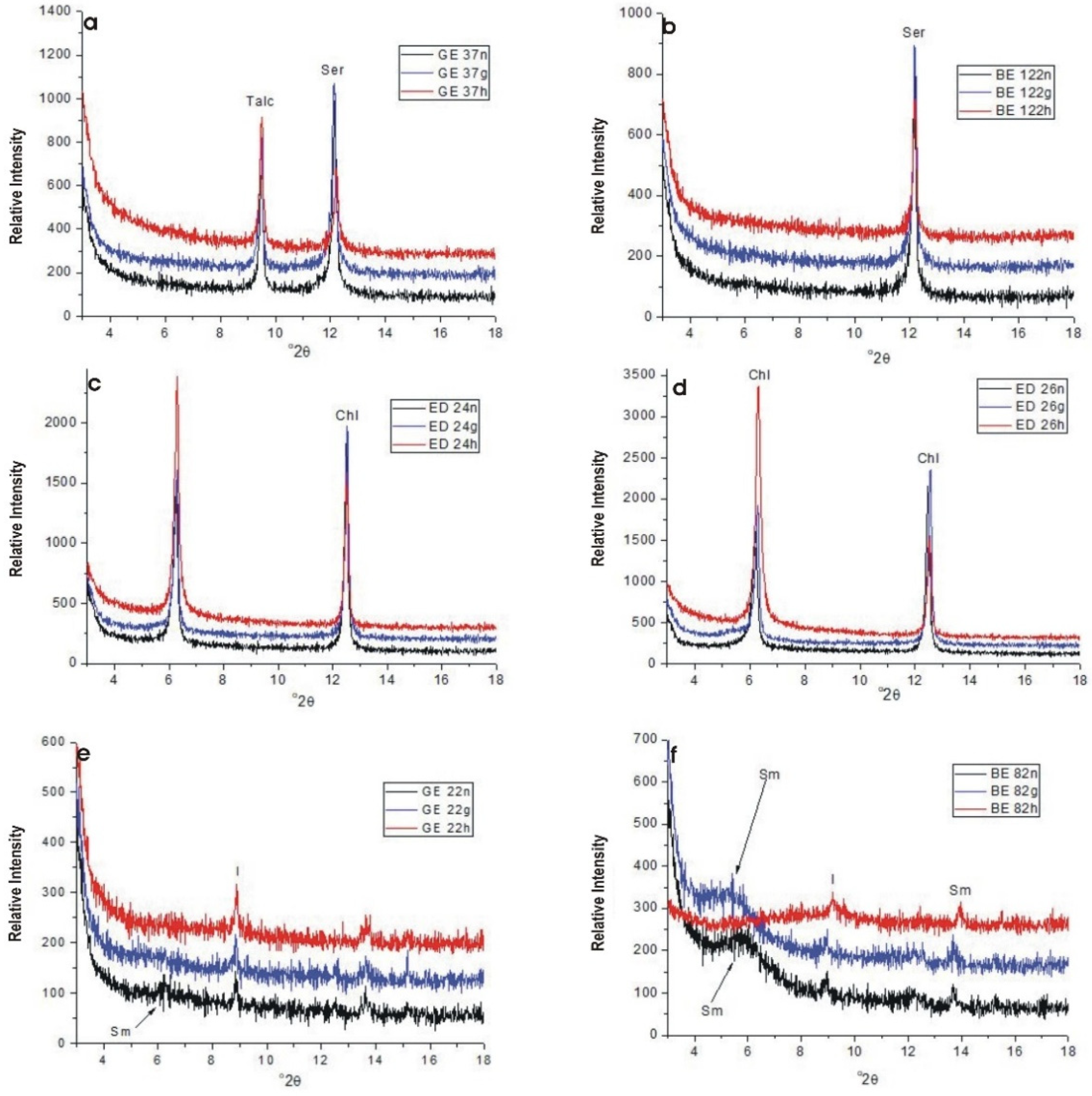
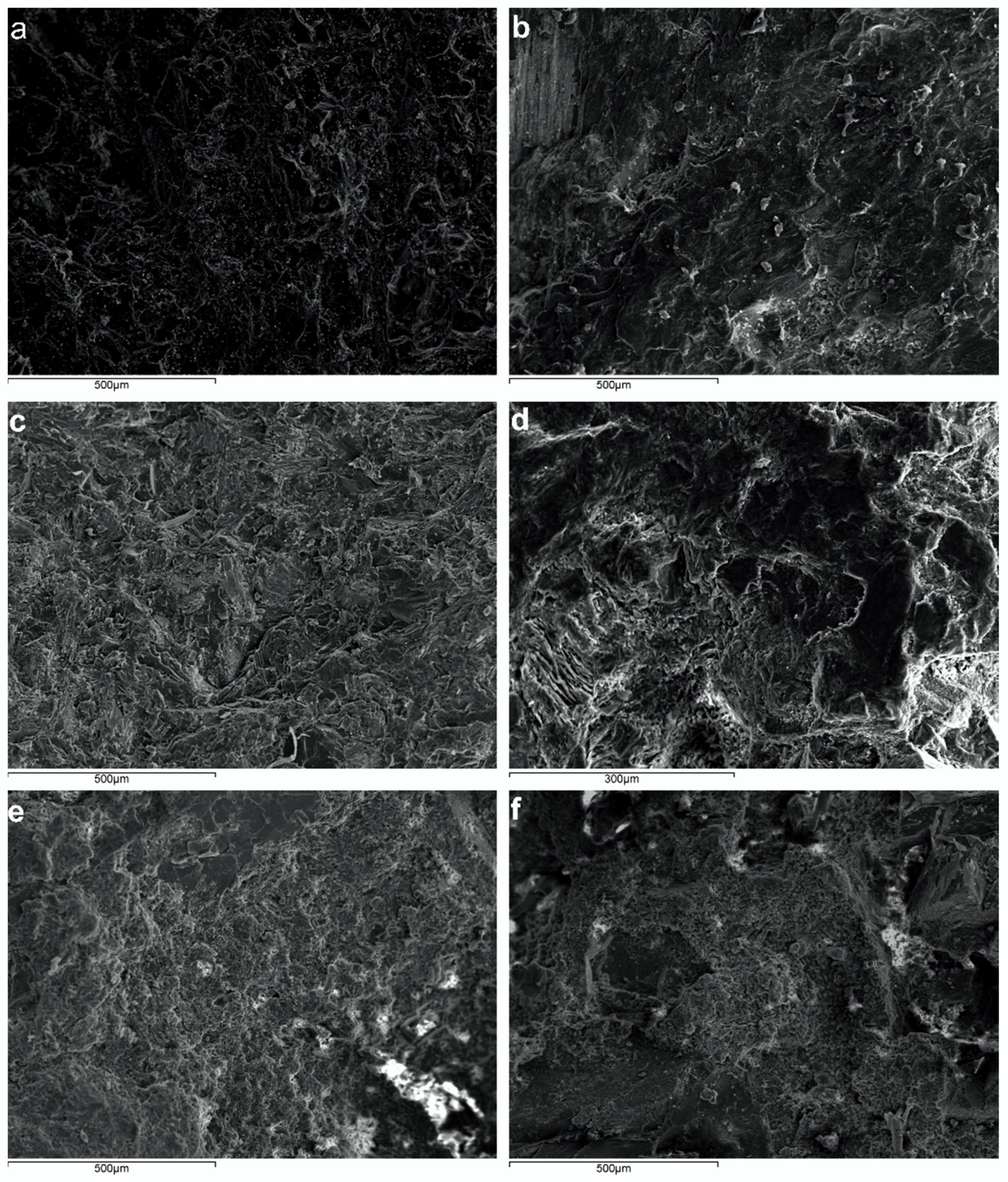
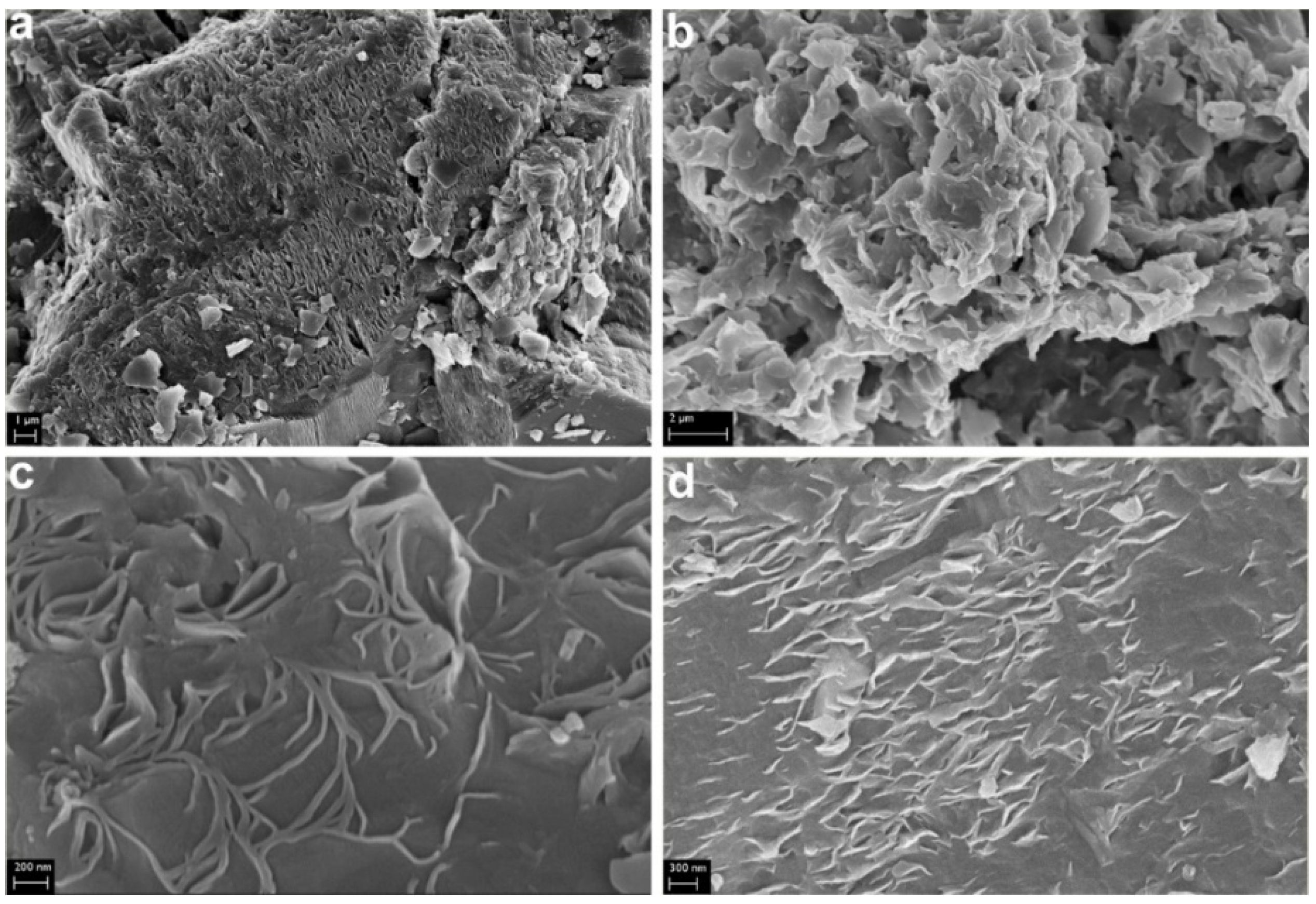
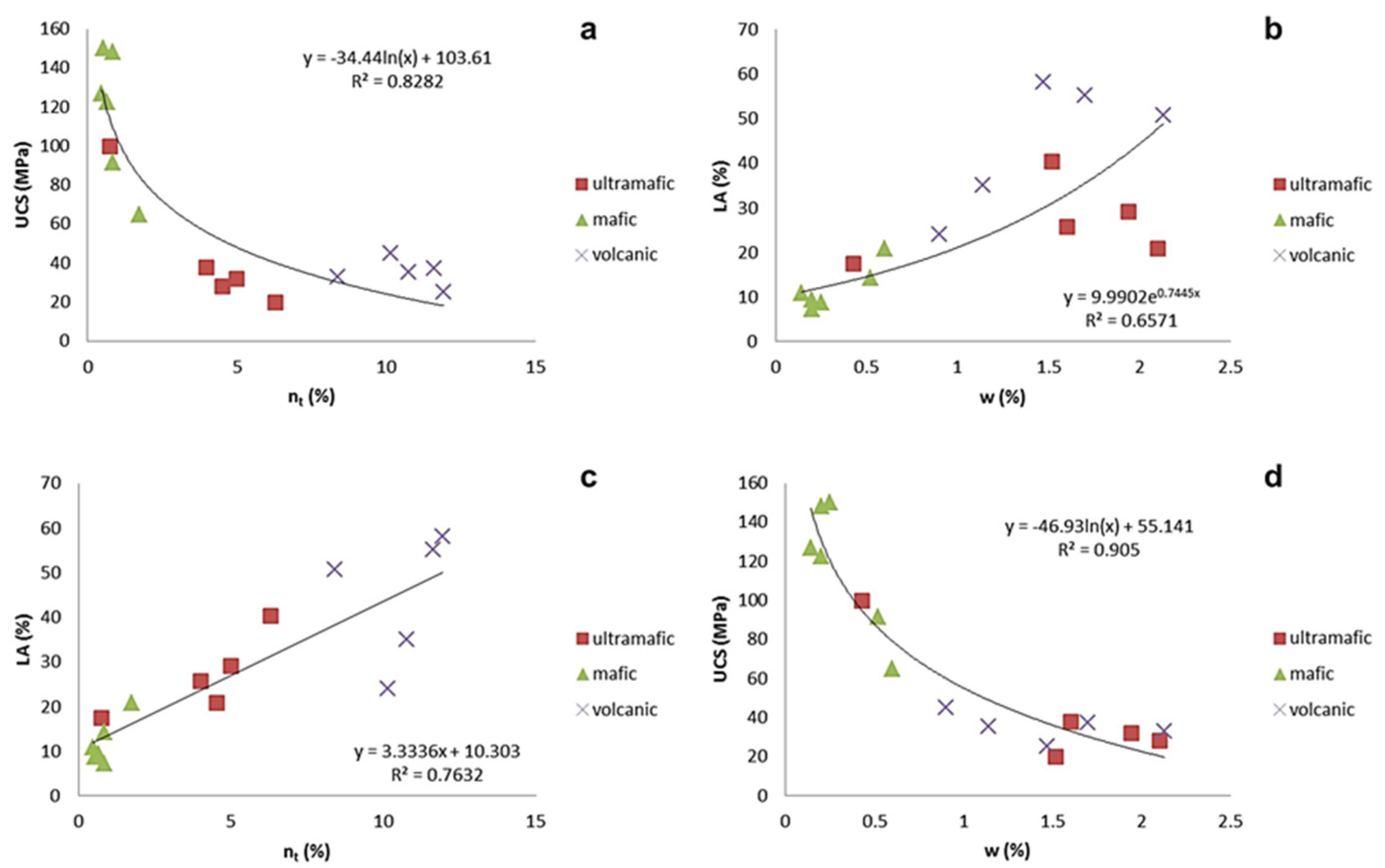



| Ultramafic Rocks | Mafic Rocks | Volcanic Rocks | ||||||||||||||
|---|---|---|---|---|---|---|---|---|---|---|---|---|---|---|---|---|
| 1 | 2 | 3 | 4 | 5 | 6 | 7 | 8 | 9 | 10 | 11 | 12 | 13 | 14 | 15 | 16 | |
| Samples | BE.103 | GE.37 | ED.59 | ED.115 | GE.42 | BE.43 | ED.26 | ED.24 | ED.110 | KIL.2 | KIL.3 | BE.82 | GE.22 | GE.23 | BE.81 | BE.101 |
| Ol | - | 43.7 | - | - | - | - | - | - | - | - | - | - | - | - | - | - |
| Opx | - | 3.9 | - | - | - | - | - | - | - | - | - | - | - | - | - | - |
| Cpx | 5.1 | - | - | 1.1 | 5.5 | 6.6 | 26.5 | 27.0 | 3.1 | 25.9 | 19.4 | 7.6 | - | - | 8.7 | 5.9 |
| Sp | 6.5 | 6.3 | 5.3 | 7.1 | 5.0 | - | - | - | - | - | - | - | - | - | - | - |
| Qtz | - | - | - | - | - | 6.0 | - | - | 2.1 | 5.1 | 4.2 | - | 30.5 | 15.8 | - | - |
| Plg | - | - | - | - | - | 46.5 | 2.0 | - | 46.0 | 39.9 | 51.1 | 52.8 | 31.0 | 45.7 | 55.1 | 56.2 |
| Kfs | - | - | - | - | - | - | - | - | - | - | 1.3 | 25.2 | 30.5 | 19.4 | 25.1 | 30.1 |
| Bi | - | - | - | - | - | - | - | - | - | - | - | 5.6 | 2.1 | 9.4 | 6.1 | 2.4 |
| Ttn | - | - | - | - | - | 2.5 | 4.1 | 2.5 | - | 1.7 | 0.9 | - | - | - | - | - |
| Ilm | - | - | - | - | - | - | 2.0 | - | - | - | - | - | - | - | - | - |
| Mgt | - | 4.6 | 5.7 | 3.2 | - | 4.0 | - | - | - | - | - | - | - | - | - | - |
| Hem | - | - | - | - | - | - | - | - | - | - | - | 2.0 | - | - | 1.0 | 1.1 |
| Ap | - | - | - | - | - | 2.4 | - | - | - | - | - | - | - | - | - | - |
| Crs | - | - | - | - | - | - | - | - | - | - | - | - | 2.0 | 4.8 | - | - |
| Ser | 87.0 | 35.0 | 84.0 | 88.6 | 83.0 | - | - | - | - | - | - | - | - | - | - | - |
| Chl | - | - | 5.0 | - | 4.0 | 10.0 | 25.0 | 23.0 | 7.2 | 9.6 | 7.2 | - | - | - | - | - |
| Act | - | - | - | - | - | 15.0 | - | - | 33.2 | 6.8 | 9.4 | - | - | - | - | - |
| Ep | - | - | - | - | 6.5 | 21.8 | 27.5 | 8.4 | 11.0 | 6.5 | - | - | - | - | - | |
| Talc | - | 6.5 | - | - | - | - | - | - | - | - | - | - | - | - | - | - |
| Prh | - | - | - | - | - | - | 8.3 | 20.0 | - | - | - | - | - | - | - | - |
| Pmp | - | - | - | - | - | - | 10.3 | - | - | - | - | - | - | - | - | - |
| Grt | 1.4 | - | - | - | 2.5 | - | - | - | - | - | - | - | - | - | - | - |
| Il | - | - | - | - | - | - | - | - | - | - | - | 3.8 | 2.5 | 4.2 | 3.1 | 3.9 |
| Sm | - | - | - | - | - | - | - | - | - | - | - | 2.8 | 1.4 | 0.7 | 0.9 | 0.4 |
| Samples | Lithology | Location | w (%) | nt (%) | LA (%) | UCS (MPa) | Petrographic Index Values (%) | Name of Index | ||
|---|---|---|---|---|---|---|---|---|---|---|
| Ultramafic rocks | 1 | BE.103 | Serp. Lherzolite | Veria–Naousa | 1.94 | 4.99 | 28.97 | 32.00 | 88.60 | Uph |
| 2 | GE.37 | Serp. Dunite | Gerania | 0.43 | 0.76 | 17.36 | 100.00 | 41.50 | ||
| 3 | ED.59 | Serp. Harzburgite | Veria–Naousa | 1.52 | 6.29 | 40.36 | 20.00 | 89.00 | ||
| 4 | ED.115 | Serp. Harzburgite | Edessa | 2.10 | 4.53 | 20.77 | 28.00 | 87.00 | ||
| 5 | GE.42 | Serp. Lherzolite | Gerania | 1.60 | 4.00 | 25.62 | 38.00 | 87.00 | ||
| Mean | 1.52 | 4.11 | 26.62 | 42.20 | 78.62 | |||||
| Minimum value | 0.43 | 0.76 | 40.36 | 20.00 | 41.50 | |||||
| Maximum value | 2.10 | 6.29 | 17.36 | 100.00 | 89.00 | |||||
| Mafic rocks | 6 | BE.43 | Diabase | Veria–Naousa | 0.25 | 0.53 | 8.72 | 150.00 | 10.00 | Mph |
| 7 | ED.26 | Met. Gabbro | Edessa | 0.60 | 1.74 | 20.68 | 65.00 | 25.00 | ||
| 8 | ED.24 | Diabase | Edessa | 0.52 | 0.84 | 14.15 | 91.33 | 23.00 | ||
| 9 | ED.110 | Diabase | Edessa | 0.20 | 0.86 | 7.31 | 148.00 | 7.20 | ||
| 10 | KIL.2 | Diabase | Guevgueli | 0.20 | 0.66 | 9.31 | 122.34 | 9.60 | ||
| 11 | KIL.3 | Diabase | Guevgueli | 0.14 | 0.48 | 10.77 | 126.72 | 7.20 | ||
| Mean | 0.32 | 0.85 | 11.83 | 117.23 | 13.67 | |||||
| Minimum value | 0.14 | 0.48 | 20.69 | 65.00 | 7.20 | |||||
| Maximum value | 0.60 | 1.74 | 7.31 | 150.00 | 25.00 | |||||
| Intermediate-acidic volcanic rocks | 12 | BE.81 | Andesite | Veria | 0.90 | 10.15 | 23.98 | 45.00 | 4.00 | Vph |
| 13 | BE.82 | Andesite | Veria | 1.14 | 10.76 | 35.00 | 35.62 | 6.60 | ||
| 14 | BE.101 | Andesite | Veria | 1.70 | 11.62 | 55.00 | 37.47 | 4.30 | ||
| 15 | GE.22 | Dacite | Ag. Theodori | 1.47 | 11.93 | 58.04 | 25.00 | 3.90 | ||
| 16 | GE.23 | Dacite | Ag. Theodori | 2.13 | 8.40 | 50.62 | 33.11 | 4.90 | ||
| Mean | 1.47 | 10.57 | 44.53 | 35.24 | 4.74 | |||||
| Minimum value | 0.90 | 8.40 | 58.04 | 25.00 | 3.90 | |||||
| Maximum value | 2.13 | 11.93 | 23.98 | 37.47 | 6.60 | |||||
| Pair | t-Test | dF | p-Value | t-Table Values | |||
|---|---|---|---|---|---|---|---|
| a = 0.01 | a = 0.02 | a = 0.05 | a = 0.10 | ||||
| Uph(%)-UCS(MPa) | 1.5202 | 4 | 0.2030 | 3.7469 | 2.9985 | 2.1318 | 1.5332 |
| Uph(%)-nt(%) | 8.8239 | 4 | 0.0009 | 3.7469 | 2.9985 | 2.1318 | 1.5332 |
| Pair | t-Test | dF | p-Value | t-Table Values | |||
|---|---|---|---|---|---|---|---|
| a = 0.01 | a = 0.02 | a = 0.05 | a = 0.10 | ||||
| Mph-UCS (MPa) | −6.2133 | 5 | 0.0015 | 3.3649 | 2.7565 | 2.0150 | 1.4758 |
| Mph-w (%) | 4.1265 | 5 | 0.0091 | 3.3649 | 2.7565 | 2.0150 | 1.4758 |
© 2018 by the authors. Licensee MDPI, Basel, Switzerland. This article is an open access article distributed under the terms and conditions of the Creative Commons Attribution (CC BY) license (http://creativecommons.org/licenses/by/4.0/).
Share and Cite
Petrounias, P.; Giannakopoulou, P.P.; Rogkala, A.; Lampropoulou, P.; Koutsopoulou, E.; Papoulis, D.; Tsikouras, B.; Hatzipanagiotou, K. The Impact of Secondary Phyllosilicate Minerals on the Engineering Properties of Various Igneous Aggregates from Greece. Minerals 2018, 8, 329. https://doi.org/10.3390/min8080329
Petrounias P, Giannakopoulou PP, Rogkala A, Lampropoulou P, Koutsopoulou E, Papoulis D, Tsikouras B, Hatzipanagiotou K. The Impact of Secondary Phyllosilicate Minerals on the Engineering Properties of Various Igneous Aggregates from Greece. Minerals. 2018; 8(8):329. https://doi.org/10.3390/min8080329
Chicago/Turabian StylePetrounias, Petros, Panagiota P. Giannakopoulou, Aikaterini Rogkala, Paraskevi Lampropoulou, Eleni Koutsopoulou, Dimitrios Papoulis, Basilios Tsikouras, and Konstantin Hatzipanagiotou. 2018. "The Impact of Secondary Phyllosilicate Minerals on the Engineering Properties of Various Igneous Aggregates from Greece" Minerals 8, no. 8: 329. https://doi.org/10.3390/min8080329
APA StylePetrounias, P., Giannakopoulou, P. P., Rogkala, A., Lampropoulou, P., Koutsopoulou, E., Papoulis, D., Tsikouras, B., & Hatzipanagiotou, K. (2018). The Impact of Secondary Phyllosilicate Minerals on the Engineering Properties of Various Igneous Aggregates from Greece. Minerals, 8(8), 329. https://doi.org/10.3390/min8080329










